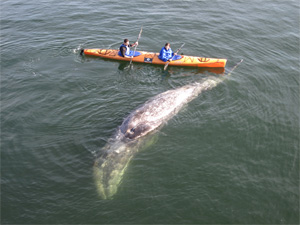
When a California gray whale (Eschrichtius robustus) yearling was spotted dead and drifting off the coast of Santa Cruz the morning of Wednesday, April 1st, attempts were made to bestow upon it a proper burial at sea. The 25-foot long calf was towed out to sea later that day, but by nightfall, the sea had brought it back and beached it in a small cove. While this presented local marine mammal biologist an opportunity to conduct necropsies and obtain tissue samples, the location of the beached cetacean prevented any such research from safely occurring. As a result, the cause of death for the 2-ton animal was not able to be determined, although the lack of contusions or obvious signs of trauma indicate that its death was probably not directly anthropogenic or by Orca Whale attack. Harbor authorities hoped to be able to tow it out further into open-ocean, but the sea state made for risky conditions. Ultimately, the decision was made to dispose of the carcass in the city’s landfill before it became a health hazard and a nuisance because of smell. On Friday morning, the body of the whale was hauled up a cliff and loaded on to a truck without incident.
The disposal of large cetaceans has often been a sensitive subject. Many feel that disposal burial in a landfill is disrespectful, or even sacrilegious. However, it is important to realize burial in a landfill is often a last resort, as maneuvering such a large animal is risky and can result in the expulsion of offensive odors and bacteria from the body (Figure 3). Moreover, removal and burial in a landfill is expensive and the cost is usually born by the public. Whenever possible (usually in remote locations where the public does not complain of the smell), authorities have left the body to decompose naturally or towed it out to sea. For example, in 2006 a gray whale was left to decay on the Big Sur coast, and researchers later found endangered California condors (Gymnogyps californianus) feeding on the remains. Towing whale carcasses out to sea prevents fouling of the coastline, and can support entire benthic communities for months, possibly years. In addition, marine biologists can also reap the benefits of cetacean falls. In 2002 researchers from the Monterey Bay Aquarium Research Institute (MBARI) were permitted to sink a gray whale carcass in the Monterey Submarine Canyon in the Monterey Bay National Marine Sanctuary for research purposes. The result was the discovery of a bone-eating species of worm, and a segment in BBC’s nature documentary series, “Blue Planet.”
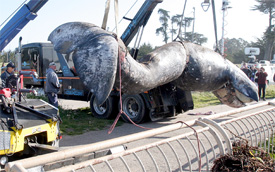
Some of the more unconventional and controversial methods of disposal of cetacean carcasses have included the use of explosives to disintegrate and disperse the remains, however, such incidences have proven to be a result of poor planning and a lack of rational decision making as using explosives to dispose of large marine mammal corpses has resulted in communities being showered in bits of whale ranging from irritating particulates of whale viscera, to blubber chunks large enough to crush cars ¼ mile away from the blast site. Others have suggested flensing the animal and allowing the local residents to benefit from rendering its fat into oil, but there is a glaring lack of facilities and volunteers with the ability and knowledge to do so, not to mention that the costs involved in processing a single whale carcass would probably exceed the benefits of the operation. This combined with the stigma associated with whale flensing and the fact that the Marine Mammal Protection Act protects cetaceans dead or alive makes rendering whale blubber into oil a poor option. Others have suggested extracting the whale bones for education and outreach purposes, but again, the costs of such an undertaking are extremely high with relatively few buyers, and this still leaves the dilemma of disposing of the soft tissue of the animal.
In this most recent case, the best option was to dispose of the body in a landfill. Authorities attempted to tow it back out to sea, but it was washed back, and conditions made the second attempt too risky. Leaving the whale to decay naturally would have posed a health hazard and resulted in offensive odors along the coastline for months, and other options as previously discussed were simply not feasible or reasonable methods of disposing of the gray whale carcass.
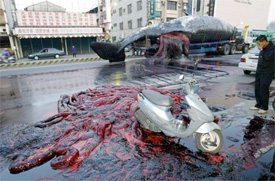
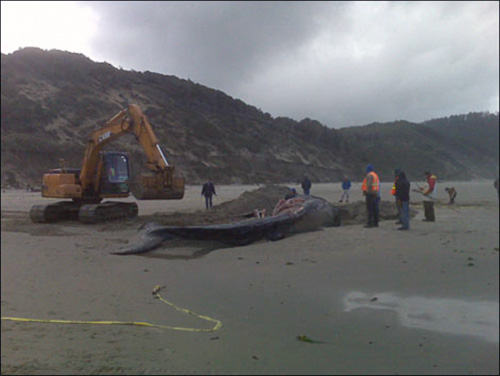
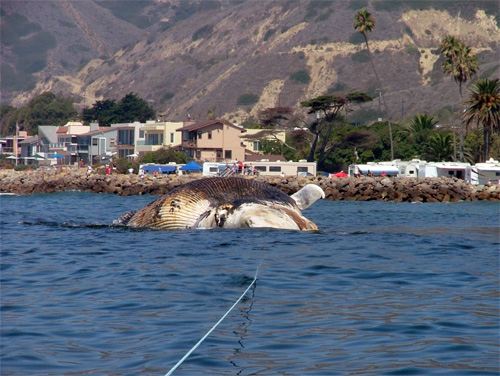
|